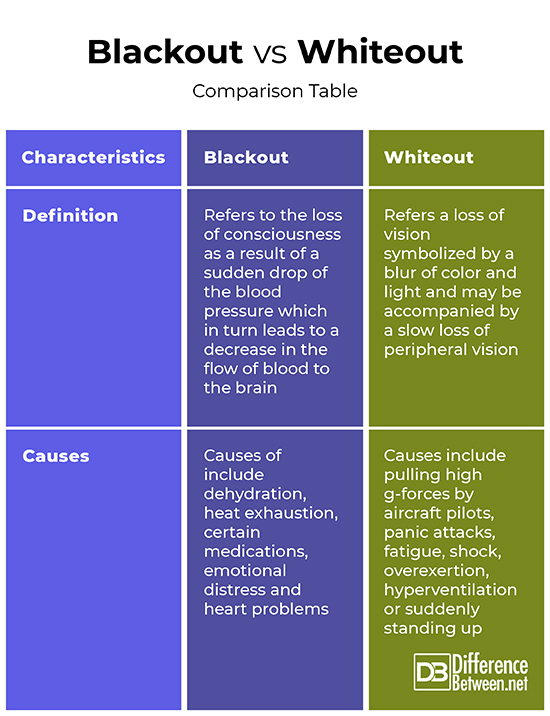Difference Between Blackout and Whiteout
The loss of consciousness is not an uncommon condition. This especially occurs as an inexperienced customer is taken through a series of aerial maneuvers. As a result of the pull in-negative and positive Gs, temporary loss of consciousness accompanied by nausea, lightheadedness and cold skin may occur. Blackouts and whiteouts are some of the conditions described. They are common in fighter pilots, amusement park rides, medical conditions, auto accidents, strenuous activities, some medications and medical conditions may create exposures for these two. Although quite similar, they have some differences.

What Is a Blackout?
Also referred to as fainting, this is the loss of consciousness as a result of a sudden drop in the blood pressure which in turn leads to a decrease in the flow of blood to the brain.
Among other causes include dehydration, heat exhaustion, certain medications, emotional distress and heart problems among others.

What is a Whiteout?
Also referred to as a grey out, this is a loss of vision symbolized by a blur of color and light. It may also be accompanied by a slow loss of peripheral vision. A whiteout may also be caused by physical exertion and cardiovascular changes. Whiteouts caused by physical exertion however subside within a few minutes of rest while whiteouts caused by cardiovascular changes are more common in ageing persons.
Among other causes include panic attacks, fatigue, shock, overexertion, hyperventilation or suddenly standing up.
Similarities between Blackout and Whiteout
- Both are common in fighter pilots than the average person
- Both are caused by high accelerations in fighter pilots commonly referred to as maximum g-force
Differences between Blackout and Whiteout
Definition
Blackout refers to the loss of consciousness as a result in a sudden drop of the blood pressure which in turn leads to a decrease in the flow of blood to the brain. On the other hand, whiteout refers a loss of vision symbolized by a blur of color and light and may be accompanied by a slow loss of peripheral vision.
Causes
Causes of a blackout include dehydration, heat exhaustion, certain medications, emotional distress and heart problems. On the other hand, causes of a whiteout include pulling high g-forces by aircraft pilots, panic attacks, fatigue, shock, overexertion, hyperventilation or suddenly standing up.
Blackout vs. Whiteout: Comparison Table

Summary of Blackout vs. Whiteout
Blackout refers to the loss of consciousness as a result of a sudden drop in the blood pressure which in turn leads to a decrease in the flow of blood to the brain. On the other hand, whiteout refers to a loss of vision symbolized by a blur of color and light and may be accompanied by a slow loss of peripheral vision. Both are, however, more common in fighter pilots than the average person.
- Difference Between Profit Center and Investment Center - July 2, 2022
- Difference Between Anti-Trust and Anti-Competition - June 6, 2022
- Difference Between Stocktaking and Stock Control - June 6, 2022
Search DifferenceBetween.net :
Leave a Response
References :
[0]Stepanek J & Davis J. Fundamentals of Aerospace Medicine. Lippincott Williams & Wilkins Publishers, 2008. https://books.google.co.ke/books?id=_6hymYAgC6MC&printsec=frontcover&dq=whiteout,+blackout,+greyout,+and+redout&hl=en&sa=X&ved=0ahUKEwiShd3FmuvpAhVOyYUKHdSoDogQ6AEIazAI#v=onepage&q&f=false
[1]Stepanek J & Davis J. Fundamentals of Aerospace Medicine. Lippincott Williams & Wilkins Publishers, 2008. https://books.google.co.ke/books?id=_6hymYAgC6MC&printsec=frontcover&dq=whiteout,+blackout,+greyout,+and+redout&hl=en&sa=X&ved=0ahUKEwiShd3FmuvpAhVOyYUKHdSoDogQ6AEIazAI#v=onepage&q&f=false
[2]Asst Prof David G. Newman. Flying Fast Jets: Human Factors and Performance Limitations. Ashgate Publishing, Ltd., 2014. https://books.google.co.ke/books?id=JjtzAwAAQBAJ&pg=PA40&dq=G-LOC&hl=en&sa=X&ved=0ahUKEwi1larmnOvpAhUb4OAKHUttDfYQ6AEILzAB#v=onepage&q=G-LOC&f=false
[3]Shane S. Bush. Neuropsychological Practice with Veterans. Springer Publishing Company, 2012. https://books.google.co.ke/books?id=txyrayKI_NMC&pg=PA261&dq=G-LOC&hl=en&sa=X&ved=0ahUKEwi1larmnOvpAhUb4OAKHUttDfYQ6AEIQDAD#v=onepage&q=G-LOC&f=false
[4]Image credit: https://live.staticflickr.com/5126/5341730048_c86deb0fea_b.jpg
[5]Image credit: https://cdn.pixabay.com/photo/2015/11/25/10/38/sun-1061662_960_720.jpg
